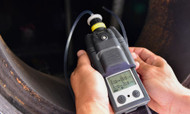The Different Ways To Measure VOCs in the Air
Posted by William Kimmell on 21st Sep 2022
Volatile organic compounds (VOCs) are substances that can come from various sources and are harmful to humans. Because many VOCs are difficult for humans to detect without assistance, we have technological devices that can do that for us. Discover the different ways to measure VOCs in the air.
Photoionization Detector (PID)
PIDs are excellent VOC detectors because they are inexpensive and can detect various gases. They work by bouncing ultraviolet light off atoms in the air to shake an electron loose. VOCs are “volatile” because they are less stable than other substances and lose electrons more easily. So, if the PID manages to ionize a substance, VOCs are present in the air.
Flame Ionization Detector (FID)
An FID works similarly to PIDs, except it uses fire instead of light to ionize atoms in the air. Like PIDs, the ionization process creates an electric current that these devices monitor and then display results on a readout screen for people. This is important because it’s not just the presence of a VOC that spells danger but a high parts-per-million (ppm) ratio in the air.
Metal Oxide Semiconductor Sensor (MOS)
MOS detectors work differently from the other two types on this list. Instead of ionizing particles, MOSs create an electric current that VOCs disrupt by stealing (aka absorbing) oxygen atoms away from the sensor. This changes the electric current, alerting the sensor to the presence of VOCs in the air.
The Right Sensor for the Job
Each of these sensors is a different way of measuring VOCs in the air. PIDs, for example, are excellent at detecting substances like aromatics, ketones, ethers, alcohols, and olefins. FIDs are more common in businesses such as the automotive industry because they work better at detecting hydrocarbons. MOS detectors are a good option if you work in a low-humidity area.
If you want to protect your workplace using photoionization sensors, check out our supply at TG Technical Services. We carry a variety of detectors designed for use in businesses, warehouses, parking garages, plants, and public buildings.

